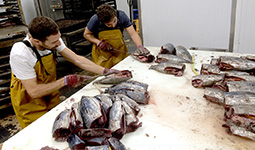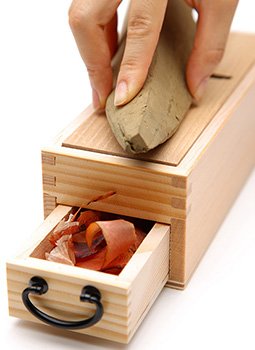Home > Highlighting JAPAN > Highlighting Japan November 2016 > The World of Japanese Cuisine
Highlighting JAPAN


Starting with Stock
Whether it be miso soup in the morning, a bowl of ramen at lunch or a multi-course kaiseki ryori dinner at night, good Japanese food is typically defined by its stock, its lovingly prepared dashi.
Human beings can detect five basic tastes: sweet, sour, salty, bitter and umami. Umami was discovered and named in 1907 by Dr. Kikunae Ikeda (1864–1936) of what is now the University of Tokyo. Comprising glutamic acid, inosine acid, and guanylyl acid, umami can be detected to varying degrees in vegetables, meat, fish, seaweed and other foodstuffs.
In many cuisines around the world, broths are made by extracting the flavours contained in certain ingredients through simmering. In French cuisine, for example, bouillon is prepared by simmering animal bones, vegetables and aromatic herbs and is used as a base for soups and sauces. In Chinese cooking, a master stock is prepared with a wide variety of spices and flavorings and used for poaching meats. In Japan, dashi stock is prepared by simmering or steeping ingredients that are packed with umami. The dashi produced is used as the base for many Japanese dishes, such as one-pot nabe stews, miso soup and all manner of noodle dishes.
The ingredients typically used to make dashi, either singularly or in combination, are katsuobushi (dried, fermented bonito), dried kombu kelp, niboshi (dried sardines) and dried shiitake mushrooms.
“One of the obvious characteristics of dashi ingredients is that they have been dried,” says Jun Nakayama, manager of the Wadakyu stall at Tokyo’s Tsukiji Fish Market. “Desiccation intensifies the ingredients’ flavors and also means they can be stored for a long time. It is said that samurai carried blocks of katsuobushi with them as an emergency food supply going into battle.”
Wadakyu, which was founded in 1925, specializes in the production and sale of katsuobushi. Production of authentic katsuobushi takes about four months to complete, the process entailing filleting the katsuo bonito, boiling and deboning the fillet, steaming it, cultivating mold on the surface and periodically drying it in the sun. The finished product looks like a hunk of wood and has been certified as the hardest food on the planet by Guinness World Records.
To make dashi from katsuobushi, finely shaved katsuobushi flakes called kezuribushi is steeped in hot water to extract the maximum flavor. Kombu on the other hand is simmered, for about thirty minutes. The most basic dashi is prepared by first simmering the kombu and then adding the katsuobushi.
In the past, Japanese families shaved katsuobushi by themselves, but today most households prefer to use ready-made flakes. Nevertheless, the laborious and time-consuming nature of traditional dashi preparation is testimony to the long history and wisdom of Japanese culinary culture.
According to the non-profit organization Umami Information Center, dashi made of katsuobushi and kombu combined can increase the flavor of a soup by a factor of seven or eight compared with a soup using only one of the two ingredients. In addition, the strong umami flavor generated by dashi reduces the impulse to add too much unhealthy salt to dishes.
“The use of dashi properly made using all natural ingredients brings entirely different flavors to the dining experience,” says Nakayama. “In recent years, there has been a huge increase in the number of foreigners who know about dashi and what umami brings to food. I am sometimes peppered with a barrage of questions at the stall from foreign customers, something I find delightful.”
In response to growing demand overseas, Wadakyu started to produce katsuobushi in Galicia, Spain in 2015. Katsuobushi cannot be exported to Europe owing to regulations concerning its production method, which explains why many Japanese restaurants in Europe use katsuobushi produced overseas.
“I had a bowl of soup in a Japanese restaurant in Paris about ten years ago, but it did not taste so good,” says Wadakyu President Sachiyuki Wada. “The restaurant owner told me he could do nothing about it because he was not allowed to import katsuobushi.”
Wada chose Galicia as the location for production because it is a port through which many European bonito are landed before canning. The bonito brought into Galicia is not significantly different in quality from that used to make katsuobushi. Moreover, the dry Spanish climate is well suited to the katsuobushi production process.
Wada has been visiting wholesalers and restaurants in many parts of Europe to promote Spain-produced katsuobushi. The product has come to be highly valued by chefs at Japanese and other restaurants besides.
“Japanese people have the cultural custom of making maximum use of food materials such as fish and vegetables,” says Wada. “After making dashi using katsuobushi, for example, we might use the squeezed-out and dried flakes a second time as a topping for rice. We want to expand and promote that culture through our sales of katsuobushi as well.”
© 2009 Cabinet Office, Government of Japan









